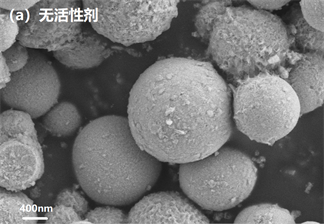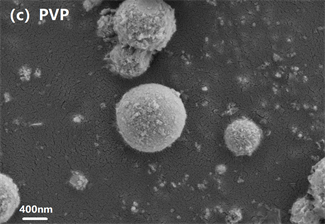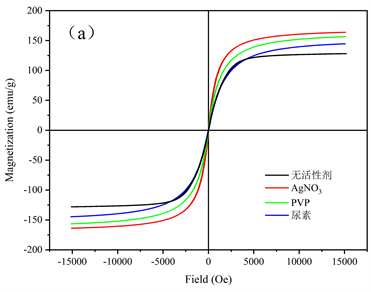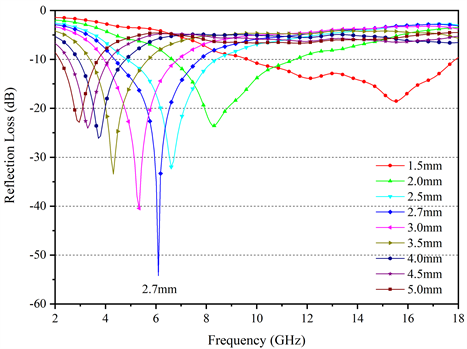Material Sciences
Vol.
12
No.
04
(
2022
), Article ID:
50693
,
9
pages
10.12677/MS.2022.124031
非晶合金Fe-B-P的制备及吸波性能研究
贾启才,曾庆轩*,乔小晶
北京理工大学机电学院,北京
收稿日期:2022年3月20日;录用日期:2022年4月15日;发布日期:2022年4月25日

摘要
利用液相还原法制备了球形Fe-B-P非晶态合金颗粒,研究了不同活性剂的添加对合金颗粒的微观形貌、结构特征、磁性能和吸波性能的影响。结果表明,不同活性剂的加入有利于颗粒粒径的减小,并避免颗粒团聚。活性剂的加入会促进合金呈完全非晶态结构,并使合金颗粒的饱和磁化强度明显提高,这有利于提高其软磁性能。AgNO3作活性剂时,合金颗粒呈最大的饱和磁化强度值为164 emu/g;在吸收体厚度为2.7 mm、匹配频率为6.1 GHz时反射损耗出现最小值为−54.21 dB,有效吸收带宽为3.3 GHz (4.4~7.7 GHz)。由此可见,非晶态合金Fe-B-P具备优异的软磁性能和吸波性能,在吸波材料领域具有广阔的应用前景。
关键词
Fe-B-P,非晶合金,磁性能,吸波性能

Preparation and Microwave Absorption Properties of Amorphous Alloy Fe-B-P
Qicai Jia, Qingxuan Zeng*, Xiaojing Qiao
School of Mechatronical Engineering, Beijing Institute of Technology, Beijing
Received: Mar. 20th, 2022; accepted: Apr. 15th, 2022; published: Apr. 25th, 2022

ABSTRACT
Amorphous alloy Fe-B-P spherical particles were prepared by liquid phase reduction method. The effects of different active agents on the microstructure, structural characteristics, magnetic properties and microwave absorption properties of the alloy particles were studied. The results show that the addition of different active agents is conducive to the reduction of particle size and to avoid particle agglomeration. The addition of active agent would promote the complete amorphous structure and significantly improve the saturation magnetization of the alloy particles, which is conducive to improve its soft magnetic properties. While AgNO3 is used as an active agent, the saturation magnetization of the sample presents the maximum value of 164 emu/g, and the minimum reflection loss is −54.21 dB with the absorber thickness of 2.7 mm and the matching frequency of 6.1 GHz. Meanwhile, the effective absorption bandwidth is 3.3 GHz (4.4~7.7 GHz). Therefore, amorphous alloy Fe-B-P presents excellent soft magnetic properties and microwave absorption properties, which has broad application prospects in the condition of microwave absorption materials.
Keywords:Fe-B-P, Amorphous Alloy, Magnetic Properties, Microwave Absorption Properties

Copyright © 2022 by author(s) and Hans Publishers Inc.
This work is licensed under the Creative Commons Attribution International License (CC BY 4.0).
http://creativecommons.org/licenses/by/4.0/


1. 引言
随着电子技术的高速发展,手机等电子设备的工作频率上升到GHz波段,然而这些设备产生的电磁干扰不仅会影响其他电子设备的正常工作,还会对人体健康产生极大的危害。因此,如何抑制电磁干扰、减少电磁污染问题成为重要的研究课题。使用电磁波吸收材料吸收电磁波来衰减电磁波强度是解决电磁干扰问题的有效方案 [1] [2] [3] [4] [5]。作为一种重要的磁性金属材料,铁基非晶合金由于具有优异的软磁性能(如高磁导率、高饱和磁化强度等)而被广泛应用于各种工程领域,如磁芯、催化剂等 [6] [7] [8]。与结晶磁相相比,非晶态的无序超密结构具有更高的电阻率,使得非晶磁性材料能在更高频率内使用且具有更小的涡流损耗 [9]。
近年来,通过在无机金属水溶液中添加硼氢化钠(NaBH4)还原金属离子得到的金属硼化物得到了广泛的研究,其相比机械化法和水雾法具有很多优点如:工艺简单和生产率高等 [10] [11]。利用液相化学还原法制备得到的Fe-B-P非晶合金具有高饱和磁化强度、低矫顽力等优异的软磁性能而受到广泛的关注 [12] - [17]。其中,日本东北大学的Shimada等人制备了非晶态的Fe-B-P亚微米球形及链状结构,研究了不同的工艺条件对其结构及性能的影响,结果表明,铂离子的加入可以有效控制颗粒的大小而不会影响材料的软磁性能 [15] [16] [17]。X.Y. Yang和G. Ababei等人通过研究发现聚乙烯吡咯烷酮(PVP)的加入可有效控制颗粒尺寸、避免颗粒团聚,并且制备得到的纳米颗粒为完全非晶态结构 [18] [19]。
本文利用液相还原法来制备了Fe-B-P非晶态合金,分别以AgNO3、PVP、尿素为活性剂,研究了样品的磁性能和微波吸收性能。其中AgNO3作为活性剂的加入促使Fe-B-P非晶态合金具有优异的微波吸收性能,这在之前是鲜有文献报道的。
2. 实验
2.1. 化学试剂
氯化亚铁(FeCl2·4H2O),氯化铵(NH4Cl),柠檬酸钠(C6H5Na3O7·2H2O),次亚磷酸钠(NaH2PO2·H2O),氢氧化钠(NaOH),硼氢化钠(NaBH4),硝酸银(AgNO3),聚乙烯吡咯烷酮(PVP),尿素,乙醇,以上试剂从国药集团化学试剂有限公司购买,可直接使用而无需进一步提纯处理。
2.2. 样品制备
本文通过液相化学还原法来制备Fe-B-P亚微米合金颗粒,具体步骤如下:依次称取10 g FeCl2·4H2O、4 g NH4Cl、12 g C6H5Na3O7·2H2O和8 g NaH2PO2·H2O于50 ml去离子水中搅拌至完全溶解,并添加一定浓度的活性剂,然后配制4 mol·L−1的NaOH溶液调节反应溶液pH值为9,配制NaBH4溶液作为还原剂诱导化学反应的进行,反应一段时间后得到具有优异软磁性能的Fe-B-P合金颗粒。用磁铁收集磁性颗粒,用去离子水和乙醇各清洗2~3次,并于60℃真空干燥。
2.3. 样品表征
使用扫描电子显微镜(SEM, ZEISS Gemini 300)观察Fe-B-P合金颗粒的微观形貌。使用X-射线衍射仪(XRD, Bruker D8 Advance)分析样品的组成和结构。使用振动样品磁强计(VSM, BKT-4500)测试样品在常温下的静态磁性能,测试磁场范围为±15 kOe。使用矢量网格分析仪(VNA, Agilent 85071E)测试样品在2~18 GHz范围的电磁参数,然后根据传输线理论计算材料对电磁波的反射损耗值(RL)。
3. 结果与讨论
3.1. 形貌分析
使用SEM测试了样品的形貌特征,结果如图1所示。由SEM图可知,非晶合金Fe-B-P颗粒呈球形。图1(a)显示未添加活性剂时合金颗粒粒径分布在0.5~1.7 μm之间,平均粒径为1 μm,球形表面较为光滑。通过对比可以发现,不同活性剂的添加有利于减小球形颗粒的粒径,并使颗粒分布更为分散。添加AgNO3和PVP之后颗粒平均粒径为0.7 μm;添加尿素之后粒径分布在0.2~0.5 μm,且此时平均粒径最小为0.4 μm,粒径分布更为均匀。




Figure 1. SEM images of samples obtained by adding different active agents
图1. 添加不同活性剂制备得到的样品SEM图
3.2. 结构表征
图2为添加不同活性剂得到Fe-B-P样品的XRD图谱。由图可知,未添加活性剂的样品仅在40˚~55˚之间存在一个典型非晶态的宽漫散射峰,表明此时样品呈非晶态。添加PVP和尿素之后未出现吸收峰,而加入AgNO3之后在2θ = 37˚、42˚、65˚和77˚出现了Ag的特征衍射峰,表明加入不同活性剂之后所得到的样品为完全非晶态,加入AgNO3之后有金属Ag生成。

Figure 2. XRD patterns of samples obtained by adding different active agents
图2. 添加不同活性剂得到的样品XRD图谱
3.3. 磁性能
磁性材料是高频电磁波吸收器的重要组成部分,电磁波吸收材料的性能在很大程度上取决于材料的磁性,因为磁性材料的高饱和磁化强度(Ms)会导致GHz范围内的高复磁导率。根据著名的Snoek公式 [20],对于大多数球状磁性块材,其频散特征参数——共振频率(fr)和静态磁导率(μs)的乘积由静态磁参数确定:
(1)
式中,旋磁比γ ≈ 3 GHz/kOe。由此可见同种成分的材料,共振频率同静态磁导率成反比,因此材料的微波吸收性能特别是应用频率受到其本征参数——饱和磁化强度Ms的限制。饱和磁化强度的值强烈依赖于化学成分和结晶度。
因此,用VSM在室温下测量了添加不同的活性剂之后制备的Fe-B-P颗粒磁滞回线,结果如图3所示。由图可知,未添加活性剂时样品的饱和磁化强度为128 emu/g。当添加不同的活性剂之后饱和磁化强度均增大,矫顽力(Hc)值也随着饱和磁化强度的增大而增大。加入AgNO3之后饱和磁化强度最大为164 emu/g,明显低于羰基铁粉的值 [21],这主要是因为合金样品中包含非磁性元素B和P,降低了样品对外部磁场的磁响应。矫顽力值的增加是因为添加活性剂后内应力增加而导致的完全非晶态结构。
3.4. 吸波性能
为了评估Fe-B-P非晶合金的微波吸收性能,在2~18 GHz频率范围内测试了材料的电磁参数,包括复介电常数( )和复磁导率( )。其中 和 分别为复介电常数的实部和虚部,如图4(a)、图4(b)所示,其分别代表对电能的极化能力和损耗能力。 和 分别为复磁导率的实部和虚部,如图4(c)、图4(d)所示,分别表示对磁能的储存和消耗能力。通常用电损耗角正切(tanδe)和磁损耗角正切(tanδm)来描述材料的损耗能力,如式(2)和式(3)所示,其值越大损耗能力越强,图4(e)、图4(f)为计算出的tanδe和tanδm曲线图。


Figure 3. Hysteresis loops of samples obtained by adding different active agents
图3. 添加不同活性剂得到的样品磁滞回线






Figure 4. Electromagnetic parameter curves of samples obtained by adding different active agents: (a) the real part ε' and (b) the imaginary part ε'' of the complex permittivity; (c) the real part μ' and (b) the imaginary part μ'' of the complex permeability; (e) dielectric loss tanδe and (f) magnetic loss tanδm
图4. 添加不同活性剂时样品的电磁参数曲线:(a) 复介电常数实部ε';(b) 复介电常数虚部ε'';(c) 复磁导率实部μ';(d) 复磁导率虚部μ'';(e) 介电损耗正切tanδe;(f) 磁损耗正切tanδm
(2)
(3)
图5给出了由电磁参数计算出的吸收特性。微波吸收特性可以用反射损耗(RL)来表示。根据传输线理论 [22],RL可由式(4)来表示:

Figure 5. Reflection loss curve of samples with AgNO3 as active agent
图5. AgNO3作活性剂时样品的反射损耗曲线
(4)
式中,Zin是归一化输入阻抗,其吸收体基于金属反射器,可通过式(5)表示:
(5)
式中,d是吸收体的厚度,f是频率,c是自由空间中的光速,μ0是自由空间磁导率,μ是复磁导率,ε0是自由空间介电常数,ε是复介电常数。
使用矢量网格分析仪测量了Fe-B-P合金颗粒在2~18 GHz频率范围的电磁参数如图4所示。由图4(a)和图4(b)可知,未添加活性剂时复介电常数实部ε'和虚部ε''呈现最大值,而AgNO3作活性剂时ε'和ε''呈现最小值。表明未添加活性剂时材料拥有更高的极化能力,而添加活性剂之后极化能力降低。另一方面,根据自由电子理论 [23]:
(6)
其中,σ是电导率,ε0是真空介电常数,f是频率。由此可知电阻率越高即电导率越低,则ε''值越低。因此,加入活性剂之后电阻率增大,这是因为此时样品的完全非晶态结构具有更高的电阻率。
图4(c)、图4(d)分别为样品的磁导率实部μ'和虚部μ''。μ'值随着频率的增大而逐渐降低,这是由于合金颗粒的涡流损耗导致的。μ''值随着频率的增大先增大后降低,这是铁磁性材料的铁磁共振导致的,在4.2 GHz处存在一个共振峰,这个峰值频率即为共振频率。图4(e)为样品的介电损耗曲线,与ε''曲线有相似的趋势,图4(f)为样品的磁损耗曲线,AgNO3作活性剂时在2~10.5 GHz范围内磁损耗值最小,而在10.5~18 GHz磁损耗值最大。通过对比可以发现,在2~18 GHz范围内样品的磁损耗值均大于介电损耗值,这表明磁损耗起着更重要的作用 [24]。
通过传输线理论计算了不同吸收体厚度下的材料的反射损耗特性。图5为AgNO3作活性剂时样品的反射损耗曲线,由图可知,吸收体的厚度对Fe-B-P非晶合金的反射损耗有很大影响,随着吸收体厚度的增加,反射损耗峰值向低频移动,这也与式(7)结果相符合,这种现象是电磁波在涂层中发生尺寸共振引起的 [25]。
(7)
式中,dm为出现吸收峰时吸收体的厚度,称为匹配厚度;fm为吸收峰的峰值频率,称为匹配频率。
当吸收体厚度为1.5 mm时,在频率为15.6 GHz时有最小反射损耗值为−18.5 GHz,有效吸收带宽(RL < −10 dB)为8.4 GHz (9.6~18 GHz)。随着吸收体厚度的增加,反射损耗峰值先增大后减小,有效吸收带宽逐渐减小。在吸收体厚度为2.7 mm、匹配频率为6.1 GHz时反射损耗峰值出现最小值为−54.21 dB,有效吸收带宽减小为3.3 GHz (4.4~7.7 GHz)。
4. 结论
通过添加不同活性剂制备了非晶态的Fe-B-P球形合金颗粒。测试结果表明,活性剂的加入会促使颗粒粒径减小,并避免颗粒团聚。未添加活性剂时样品存在一个宽的漫散射峰,表明此时样品为非晶态结构,而活性剂的加入会促进合金呈完全非晶态结构,在AgNO3作活性剂时会生成金属银。添加不同活性剂后合金颗粒的饱和磁化强度值明显提高。AgNO3作活性剂时,合金颗粒呈最大的饱和磁化强度值为164 emu/g。在吸收体厚度为2.7 mm、匹配频率为6.1 GHz时反射损耗出现最小值为−54.21 dB,有效吸收带宽为3.3 GHz (4.4~7.7 GHz)。综上所述,AgNO3的加入明显改善Fe-B-P的吸波性能,这使得Fe-B-P非晶态合金成为具有广阔应用前景的吸波材料。
基金项目
国家自然科学基金(11672041)资助。
文章引用
贾启才,曾庆轩,乔小晶. 非晶合金Fe-B-P的制备及吸波性能研究
Preparation and Microwave Absorption Properties of Amorphous Alloy Fe-B-P[J]. 材料科学, 2022, 12(04): 307-315. https://doi.org/10.12677/MS.2022.124031
参考文献
- 1. Green, M. and Chen, X. (2019) Recent Progress of Nanomaterials for Microwave Absorption. Journal of Materiomics, 5, 503-541. https://doi.org/10.1016/j.jmat.2019.07.003
- 2. Qin, F. and Brosseaou, C. (2012) A Review and Analysis of Microwave Absorption in Polymer Composites Filled with Carbonaceous Particles. Journal of Applied Physics, 111, Article ID: 061301. https://doi.org/10.1063/1.3688435
- 3. Qiang, R., Du, Y.C., Zhao, H.T., et al. (2015) Metal Organic Framework-Derived Fe/C Nanocubes toward Efficient Microwave Absorption. Journal of Materials Chemistry, 3, 13426-13434. https://doi.org/10.1039/C5TA01457C
- 4. Liu, G., Wang, L.Y., Yang, Z.H. and Wu, R.B. (2017) Synthesis of Iron-Based Hexagonal Microflakes for Strong Microwave Attenuation. Journal of Alloys and Compounds, 718, 46-52. https://doi.org/10.1016/j.jallcom.2017.05.100
- 5. Zhang, X.F., Guan, P.F. and Dong, X.L. (2010) Multidielectric Polarizations in the Core/Shell Co/Graphite Nanoparticles. Applied Physics Letters, 96, Article ID: 223111. https://doi.org/10.1063/1.3446868
- 6. Fang, Y.Z., Zheng, J.J., Wu, F.M., et al. (2010) Mesostructural Origin of Stress-Induced Magnetic Anisotropy in Fe-Based Nanocrystalline Ribbons. Applied Physics Letters, 96, Article ID: 092508. https://doi.org/10.1063/1.3330931
- 7. Daniil, M., Osofsky, M.S., Gubser, D.U. and Willard, M.A. (2010) (Fe, Si, Al)-Based Nanocrystalline Soft Magnetic Alloys for Cryogenic Applications. Applied Physics Letters, 96, Article ID: 162504. https://doi.org/10.1063/1.3402775
- 8. Caballero-Flores, R., Franco, V., Conde, A., et al. (2010) Influence of Co and Ni Addition on the Magnetocaloric Effect in Fe88−2xCoxNixZr7B4Cu1 Soft Magnetic Amorphous Alloys. Applied Physics Letters, 96, Article ID: 182506. https://doi.org/10.1063/1.3427439
- 9. Han, M.G., Liang, D.F. and Deng, L.J. (2010) Fabrication and Electromagnetic Wave Absorption Properties of Amorphous Fe79Si16B5 Microwires. Applied Physics Letters, 99, Article ID: 082503. https://doi.org/10.1063/1.3628661
- 10. Wang, Y.P., Li, H.H., Wang, Y.J., et al. (2014) Self-Assembled Fe-B Nanochains: Facile Synthesis, Magnetic and Electrochemical Properties. Materials Letters, 121, 40-43. https://doi.org/10.1016/j.matlet.2014.01.098
- 11. Bai, Y.W., Bian, X.F., Qin, J.Y., et al. (2020) The Relationship between Structures and Magnetic Properties of Fe-B Amorphous Nanoparticles. Journal of Non-Crystalline Solids, 528, Article ID: 119723. https://doi.org/10.1016/j.jnoncrysol.2019.119723
- 12. Zhang, Y.H., Yao, C., Chao, Y.S. and Qin, G.W. (2013) Influence of Annealing Treatment on Microstructure and Soft Magnetic Properties of Fe-B-P Nanoparticles Prepared by Aqueous Chemical Reduction. Hyperfine Interact, 219, 101-105. https://doi.org/10.1007/s10751-012-0757-6
- 13. Yao, C., Zhang, Y.H., Chen, J., et al. (2014) Size Controlled Preparation of Fe-B-P Submicrometre Particles and Magnetic Performance. Materials Research Innovations, 18, S4-634-S4-638. https://doi.org/10.1179/1432891714Z.000000000755
- 14. Zhang, Y.H., Wang, X.K., Yao, C. and Qin, G.W. (2016) Preparation and Characterization of Amorphous Fe-B-P Ultrafine Particles. Materials Science Forum, 848, 652-656. https://doi.org/10.4028/www.scientific.net/MSF.848.652
- 15. Shimada, Y., Endo, Y., Yamaguchi, M., et al. (2009) Production of Magnetically Soft Submicron Particles from Aqueous Solutions and Characterization. IEEE Transactions on Magnetics, 45, 4298-4301. https://doi.org/10.1109/TMAG.2009.2024951
- 16. Shimada, Y., Endo, Y., Yamaguchi, M., et al. (2011) Amorphous Submicron Particle Chains with High Permeability. IEEE Transactions on Magnetics, 47, 2831-2834. https://doi.org/10.1109/TMAG.2011.2151181
- 17. Yao, C., Shimada, Y., Muroga, S., et al. (2013) High Permeability and Electromagnetic Noise Suppression Characteristics of Fe-B-P Sub-Micron Particle Chains and Their Composites with NiZn-Ferrite Nanoparticles. Journal of Alloys and Compounds, 554, 414-418. https://doi.org/10.1016/j.jallcom.2012.11.157
- 18. Yang, X.Y., Yang, B., Li, X.P., et al. (2015) Structural-Controlled Chemical Synthesis of Nanosized Amorphous Fe Particles and Their Improved Performances. Journal of Alloys and Compounds, 651, 551-556. https://doi.org/10.1016/j.jallcom.2015.08.156
- 19. Ababei, G., Gaburici, M., Budeanu, L.-C., et al. (2018) Influence of the Chemically Synthesis Conditions on the Microstructure and Magnetic Properties of the Co-Fe-B Nanoparticles. Journal of Magnetism and Magnetic Materials, 451, 565-571. https://doi.org/10.1016/j.jmmm.2017.11.110
- 20. Wang, L., Quan, Q.C., Zhang, L.L., et al. (2018) Microwave Absorption of NdFe Magnetic Powders Tuned with Impedance Matching. Journal of Magnetism and Magnetic Materials, 449, 385-389. https://doi.org/10.1016/j.jmmm.2017.10.067
- 21. Zhou, Y.Y., Zhou, W.C., Li, R., et al. (2015) Enhanced Antioxidation and Electromagnetic Properties of Co-Coated Flaky Carbonyl iron Particles Prepared by Electroless Plating. Journal of Alloys and Compounds, 637, 10-15. https://doi.org/10.1016/j.jallcom.2015.03.014
- 22. Zhang, B.S., Feng, Y., Xiong, J., et al. (2006) Microwave-Absorbing Properties of De-Aggregated Flake-Shaped Carbonyl-Iron Particle Composites at 2-18 GHz. Ieee Transactions on Magnetics, 42, 1778-1781. https://doi.org/10.1109/TMAG.2006.874188
- 23. Liu, Q.H., Xu, X.H., Xia, W.X., et al. (2015) Dependency of Magnetic Microwave Absorption on Surface Architecture of Co20Ni80 Hierarchical Structures Studied by Electron Holography. Nanoscale, 7, 1736-1743. https://doi.org/10.1039/C4NR05547K
- 24. Jiang, Q.R., Li, H.L., Cao, Z.M., et al. (2017) Synthesis and Enhanced Electromagnetic Wave Absorption Performance of Amorphous CoxFe10-x Alloys. Journal of Alloys and Compounds, 726, 1255-1261. https://doi.org/10.1016/j.jallcom.2017.08.066
- 25. Chuai, D., Liu, X.F., Yu, R.H., et al. (2016) Enhanced Microwave Absorption Properties of Flake-Shaped FePCB Metallic Glass/Graphene Composites. Composites: Part A, 89, 33-39. https://doi.org/10.1016/j.compositesa.2016.02.010
NOTES
*通讯作者。